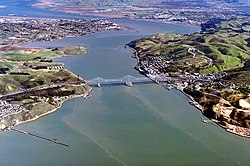Tolls are only collected from eastbound traffic after they cross from Crockett at the toll plaza on the Vallejo side of the bridge. Although the 2003 Alfred Zampa Memorial Bridge is the newer span, no toll is charged in that direction, continuing the practice of the now-demolished 1927 span. All-electronic tolling has been in effect since 2020, and drivers may either pay using the FasTrak electronic toll collection device or using the license plate tolling program. It remains not truly an open road tolling system until the remaining unused toll booths are removed, forcing drivers to slow substantially from freeway speeds while passing through. Effective January 1 – December 31, 2025 (2025-01-01 – 2025-12-31), the toll rate for passenger cars is $8. During peak traffic hours on weekdays between 5:00 am and 10:00 am, and between 3:00 pm and 7:00 pm, carpool vehicles carrying three or more people, clean air vehicles, or motorcycles may pay a discounted toll of $4 if they have FasTrak and use the designated carpool lane. Drivers without Fastrak or a license plate account must open and pay via a "short term" account within 48 hours after crossing the bridge or they will be sent an invoice of the unpaid toll. No additional toll violation penalty will be assessed if the invoice is paid within 21 days. [7] [8] [9]
Historical toll rates
Crossing the original 1927 bridge required a toll, but tolls were removed within five years after the state bought the bridge in 1940. Tolls in 1926 were originally set at $0.60 per car (equivalent to $10.66in 2024) plus $0.10 per passenger (equivalent to $1.78in 2024). This was reduced in 1938 to $0.45 per car (equivalent to $10.05in 2024) plus $0.05 per passenger (equivalent to $1.12in 2024). After the state took ownership in 1940, tolls were immediately reduced to $0.30 per car (equivalent to $6.73in 2024). In 1942, tolls were further reduced to $0.25 (equivalent to $4.81in 2024) before being removed in 1945. Tolls were reinstated in 1958 with the completion of the parallel span, set again at $0.25 (equivalent to $2.72in 2024). It was increased to $0.35 in 1970 (equivalent to $2.83in 2024), and then $0.40 in 1978 (equivalent to $1.93in 2024). [10]
The basic toll (for automobiles) on the seven state-owned bridges, including the Carquinez Bridge, was standardized to $1 by Regional Measure 1, approved by Bay Area voters in 1988 (equivalent to $2.66in 2024). [11] A $1 seismic retrofit surcharge was added in 1998 by the state legislature, increasing the toll to $2 (equivalent to $3.86in 2024), originally for eight years, but since then extended to December 2037 (AB1171, October 2001). [12] On March 2, 2004, voters approved Regional Measure 2 to fund various transportation improvement projects, raising the toll by another dollar to $3 (equivalent to $4.99in 2024). An additional dollar was added to the toll starting January 1, 2007, to cover cost overruns on the eastern span replacement of the Bay Bridge, increasing the toll to $4 (equivalent to $6.07in 2024). [13]
The Metropolitan Transportation Commission (MTC), a regional transportation agency, in its capacity as the Bay Area Toll Authority, administers RM1 and RM2 funds, a significant portion of which are allocated to public transit capital improvements and operating subsidies in the transportation corridors served by the bridges. Caltrans administers the "second dollar" seismic surcharge, and receives some of the MTC-administered funds to perform other maintenance work on the bridges. The state legislature created the Bay Area Toll Authority in 1997 to transfer the toll administration of the seven state-owned bridges to the MTC. The Bay Area Toll Authority is made up of appointed officials put in place by various city and county governments, and is not subject to direct voter oversight. [14]
Due to further funding shortages for seismic retrofit projects, the Bay Area Toll Authority again raised tolls on all seven of the state-owned bridges in July 2010. The toll rate for autos on the Carquinez Bridge was thus increased to $5 (equivalent to $7.21in 2024). [15]
In June 2018, Bay Area voters approved Regional Measure 3 to further raise the tolls on all seven of the state-owned bridges to fund $4.5 billion worth of transportation improvements in the area. [16] [17] Under the passed measure, the toll rate for autos on the Carquinez Bridge was increased to $6 on January 1, 2019; to $7 on January 1, 2022; and then to $8 on January 1, 2025. [18]
In September 2019, the MTC approved a $4 million plan to eliminate toll takers and convert all seven of the state-owned bridges to all-electronic tolling, citing that 80 percent of drivers are now using FasTrak and the change would improve traffic flow. [19] On March 20, 2020, accelerated by the COVID-19 pandemic, all-electronic tolling was placed in effect for all seven state-owned toll bridges. [20] The MTC then installed new systems at all seven bridges to make them permanently cashless by the start of 2021. [21] In April 2022, the Bay Area Toll Authority announced plans to remove all remaining unused toll booths and create an open-road tolling system which functions at highway speeds. [22]
The Bay Area Toll Authority then approved a plan in December 2024 to implement 50-cent annual toll increases on all seven state-owned bridges between 2026 and 2030 to help pay for bridge maintenance. The standard toll rate for autos will thus rise to $8.50 on January 1, 2026; $9 in 2027; $9.50 in 2028; $10 in 2029; and then to $10.50 in 2030. And becoming effective in 2027, a 25-cent surcharge will be added to any toll charged to a license plate account, and a 50-cent surcharge added to a toll violation invoice, due to the added cost of processing these payment methods. [23] [24]






